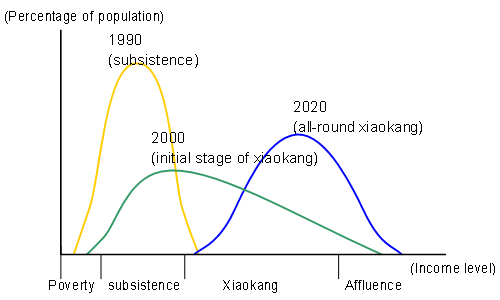In an attempt to do away with the detrimental effects of the egalitarianism of the planned economy era, Deng Xiaoping called for letting some people get rich first and pressed ahead with market-opening policies that placed priority on efficiency rather than equality. Now, 25 years later, the lives of the Chinese have on the whole improved, but income distribution has become increasingly unequal. In addition to the traditional gap between "rural" and "urban" areas and between "inland" and "coastal" regions, we now see a widening gap between "the poor" and "the rich." Against such a backdrop, the issue of income distribution came into the spotlight at the Communist Party National Congress last autumn as well as the National People's Congress and the Political Consultative Conference in March. In an effort to correct this imbalance and strive for stable, sustainable growth, China's leadership unveiled a strategy to "build a xiaokang (well-off) society in an all-round way." This signifies a major shift in China's development strategy from exclusively focusing on efficiency to paying due attention to equity.
When market-opening reforms began, Deng Xiaoping made xiaokang the goal of China's modernization. Specifically, real gross domestic product was to double from 1980 to 1990 and food and clothing shortages were to be resolved so that most people could achieve subsistence. By 2000, GDP was to be doubled again so as to achieve a xiaokang society. The modernization process was to be completed by the middle of the 21st century when China's per capita income would reach a level on par with mid-income-level countries. As for the specific contents of xiaokang , nationwide standards were set in 1991 and indexes for both rural and urban areas were put in place. Under the standards, xiaokang was comprehensively measured using 16 indexes in five categories - economic development, material life, population quality, cultural life and living environment. Since the initial stage of xiaokang has basically been achieved, Jiang Zemin put forth the target of quadrupling GDP from 2000 levels by 2020 so as to achieve a xiaokang society in an all-round way. To do so, the Chinese economy needs to grow at an annual 7.2 percent during the period in question, but even if this were to be achieved, China's per capita GDP in 2020 would just reach $3,000 based on 2000 prices and foreign exchange rates, a far cry from the roughly $30,000 level of industrial countries today.
Compared to the initial stage of xiaokang that has already been achieved, all-round xiaokang not only signifies being better off but also securing a more equitable distribution of income ( diagram ). While the initial stage of xiaokang has been achieved in terms of the national average, not all of China's citizens have attained this level. Even in 2000, some 30 million people were still suffering from lack of food and clothing and even in urban areas, some people are forced to live below the subsistence level. And while a considerable number of people have solved food and clothing problems, they have yet to reach a stage of xiaokang . According to Jiang Zemin's report, China needs to construct an all-round xiaokang society, accelerate development in the central and western regions and rural areas and embody the principle of socialism that everyone can share the fruit of modernization. Furthermore, in order to reduce the gap between urban and rural areas, authorities plan to reduce the share of farmers in the workforce to 30 percent from the present 50 percent in 20 years, basically through industrialization.
Xiaokang was initially a social ideal put forward by ancient Chinese thinkers, and in the Li Yun of the Li Ki , or Book of Rites compiled in the Earlier Han Period, it was described as being the second-best society after datong (or utopia). In a datong society, public ownership was supposed to be the norm; in contrast, xiaokang was depicted as a society in which people had self-interests, and that it needed to be governed through rites, or institutions. In view of the modern experiences of other countries that have already achieved a state of all-round xiaokang , China must swiftly set up fair and competitive markets as well as institutions such as rule by law, democracy, private property and social security.



